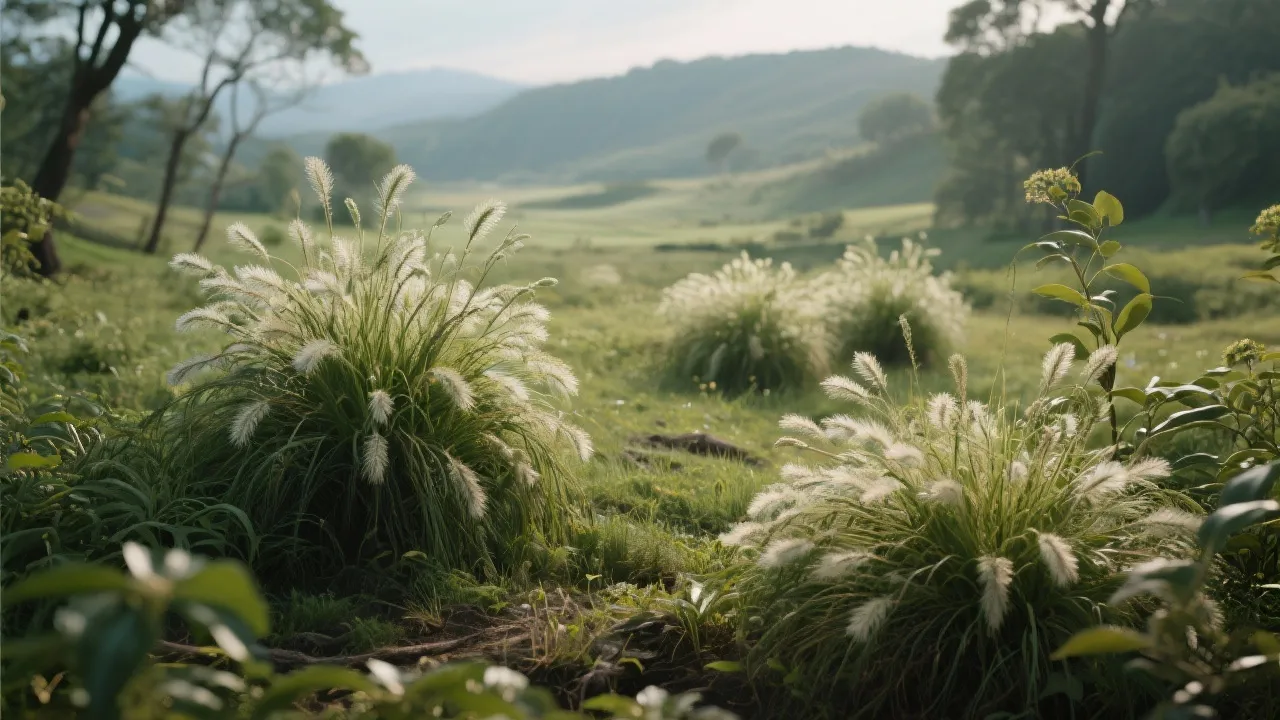Delving Into Zanc Poa Ecology
Zanc Poa, a grass species of ecological importance, enhances bio-diversity in various environments. Understanding its growth, adaptation, and uses provides insights into ecological stability and horticultural value. This article explores Zanc Poa, highlighting its unique attributes and its significance in environmental conservation.

Understanding Zanc Poa: A Botanical Overview
The Zanc Poa, a lesser-known but vital species in the grass family, plays a significant role in maintaining ecological balance. Its unique characteristics enable it to thrive in diverse climates, making it a plant of interest for botanists and environmentalists alike. This article examines the Zanc Poa’s ecological, environmental, and horticultural significance in depth, highlighting how this seemingly inconspicuous grass can have wide-ranging impacts on its ecosystem and beyond.
Ecological Significance of Zanc Poa
Zanc Poa is integral to many ecosystems owing to its adaptability and resilience. It often contributes to soil stabilization, reducing erosion, and supporting biological diversity by providing habitat and food for various fauna. This grass species is particularly crucial in preventing soil erosion on slopes and in watersheds, where its root system can hold the soil together and maintain the integrity of the ecosystem.
Furthermore, as ecological dynamics shift due to climate change, Zanc Poa serves as a model for studying adaptation and resilience in plant species. Its capacity to absorb carbon dioxide not only improves air quality but also contributes to mitigating the effects of climate change. By fostering healthy ecosystems, Zanc Poa aids in water retention, which can benefit surrounding flora and fauna.
Growth Conditions and Characteristics
The adaptability of Zanc Poa is one of its most remarkable features. Typically found in temperate climates, it has developed robust mechanisms for survival across a range of altitudes and soil types. Its growth is often seen in disturbed areas and natural grasslands where its presence helps restore ecological balance. The following characteristics exemplify why Zanc Poa is so well-suited to diverse environments:
| Characteristic | Description |
|---|---|
| Height | Typically ranges from 30 to 90 cm, though specific varieties may appear shorter or taller depending on environmental conditions. |
| Leaf Texture | Fine leaves with a bluish-green hue that add aesthetic value and enhance its ability to photosynthesize efficiently. |
| Root System | Fibrous, enhancing soil binding capacity, thereby preventing erosion and contributing to soil health. |
| Sunlight Requirements | Prefers full to partial sunlight exposure, allowing it to flourish in various light conditions. |
| Soil Preferences | Thrives in well-drained soils, showing tolerance to a range of pH levels, from slightly acidic to neutral. |
| Water Needs | Requires moderate watering, demonstrating drought resistance once established, making it suitable for low-water gardens. |
Cultural and Horticultural Value
The role of Zanc Poa extends beyond ecology into cultural and horticultural spheres. Known for its aesthetic appeal, it is utilized in landscape architecture to create serene, sustainable gardens. Its soft texture and pleasing color contribute to the design of residential and public spaces alike. Zanc Poa is often included in native plant gardens and restoration projects aimed at revitalizing habitats and promoting biodiversity.
In addition to its visual appeal, Zanc Poa is appreciated for its low maintenance requirements. Gardeners and landscapers find it an attractive option because it requires minimal intervention once established. This practicality aligns with contemporary moves toward sustainable gardening practices, reducing reliance on chemical fertilizers and excessive irrigation.
Moreover, Zanc Poa often coexists with other native plants, enriching the biodiversity of planted areas. By promoting associations with local flora, gardeners can replicate natural ecosystems, further enhancing habitat quality and support for wildlife. This inter-planting strategy helps attract various pollinators, such as bees and butterflies, which are essential for the health of many species in our landscapes.
Research and Conservation Efforts
Current research efforts focus on understanding the genetic diversity of Zanc Poa to better protect and utilize this species. By studying its genetic makeup, scientists can gain insights into how Zanc Poa adapts to varying environmental conditions, which may inform broader conservation strategies. Understanding its genetics not only enhances the conservation of Zanc Poa itself but also provides valuable data for programs aimed at preserving other vulnerable species.
Conservation initiatives aim to safeguard its natural habitats from threats like habitat destruction and invasive species. Protective measures include the establishment of conservation areas, restoration of degraded ecosystems, and ongoing monitoring of Zanc Poa populations in the wild. Various organizations and environmental groups are working to increase awareness about the importance of Zanc Poa in maintaining ecological integrity and promoting biodiversity.
Furthermore, promoting sustainable land management practices is crucial for preserving Zanc Poa populations. Landowners and agricultural entities are encouraged to adopt practices that minimize soil disturbance and encourage the growth of native grasses, including Zanc Poa. Educational programs designed to inform land users about the benefits of maintaining natural flora will significantly contribute to long-term conservation efforts.
Applications in Modern Landscaping
With an increasing focus on sustainable landscaping, Zanc Poa has found its place as a favored species among landscape architects. The push towards xeriscaping—landscaping designed to reduce or eliminate the need for irrigation—has seen Zanc Poa being incorporated into drought-tolerant gardens. Its resilience to dry conditions makes it an ideal choice for water-wise gardening initiatives.
Moreover, Zanc Poa's adaptability allows it to be a vital component in urban green spaces, where it can thrive alongside paved surfaces. Incorporating this species into urban planning contributes to the establishment of green corridors that support urban wildlife, improve air quality, and provide residents with natural spaces for recreation and relaxation.
Challenges and Threats
Despite its resilience, Zanc Poa faces several challenges that threaten its survival and ecological role. One significant threat is habitat destruction due to urban expansion, agricultural practices, and land management decisions. As human activities encroach upon natural habitats, Zanc Poa populations may decline if their environmental conditions are compromised.
Additionally, invasive species pose a considerable threat to Zanc Poa's survival. Invasive plants can outcompete Zanc Poa for resources, leading to declines in populations and biodiversity within ecosystems. Ongoing research into effective management strategies for invasive species is crucial to ensure that native species like Zanc Poa can thrive.
Climate change exacerbates these threats, altering the conditions in which Zanc Poa grows. Fluctuations in temperature and unpredictable weather patterns can stress populations, push them beyond their adaptive limits, and even lead to local extinctions if conditions become unsuitable. Understanding how Zanc Poa responds to changing climatic conditions is essential for its conservation and for developing strategies to protect and enhance its habitats.
Technological Integration in Conservation
The integration of technology into conservation efforts offers new avenues for enhancing the protection and study of Zanc Poa. Geographic Information Systems (GIS) are increasingly used to map the distribution of Zanc Poa across different regions, providing valuable data for conservationists. These tools allow for the analysis of environmental factors influencing its growth and the identification of areas most in need of conservation efforts.
Moreover, remote sensing technologies can monitor changes in land cover and habitat integrity, providing real-time data that aid in assessing the health of Zanc Poa populations. Drones equipped with cameras can facilitate the surveying of hard-to-reach areas, offering insights into habitat conditions and potential threats from invasive species.
Additionally, citizen science initiatives enable individuals to participate in monitoring efforts. Engaging the public in documenting the presence of Zanc Poa and other native species encourages community involvement and raises awareness of the importance of preserving local biodiversity.
Educational Outreach and Community Involvement
Education plays a crucial role in the conservation of Zanc Poa and its habitats. Schools, universities, and community organizations are working together to promote knowledge about native plant species and the importance of biodiversity conservation. Educational programs often feature hands-on activities, such as planting Zanc Poa in local parks or participating in restoration projects, fostering a sense of responsibility among participants.
Community engagement initiatives focus on creating an appreciation for local ecosystems, encouraging residents to adopt sustainable gardening practices and support local conservation efforts. Workshops on native plant landscaping, including Zanc Poa, provide valuable information on incorporating these species into home gardens, promoting a broader understanding of their ecological significance.
By cultivating a strong community connection with Zanc Poa, stakeholders can create advocates for sustainable land management and biodiversity conservation. This grassroots approach complements larger conservation efforts, helping to ensure that Zanc Poa remains a thriving component of local ecosystems for generations to come.
Future Directions for Research and Conservation
Looking forward, the future of Zanc Poa conservation lies in ongoing research and adaptive management practices. Continued genetic research is vital for understanding its potential to adapt to changing environmental conditions, including climate change. As genetic diversity is essential for resilience, efforts should focus on maintaining and promoting genetic variation within Zanc Poa populations.
Conservation strategies should evolve to incorporate new research findings, with adaptive management allowing for flexibility in response to changing data. Collaborations among scientists, conservationists, landowners, and governmental agencies will be critical in creating comprehensive management plans that address threats while promoting ecological health.
On a broader scale, integrating Zanc Poa into conservation education, sustainable agriculture, and forestry programs can enhance its ecological role. By recognizing Zanc Poa’s value beyond its immediate environment, stakeholders can create a more holistic approach to conservation, ensuring that it remains an integral part of our landscapes.
FAQs
What is the primary ecological function of Zanc Poa?
Primarily, Zanc Poa contributes to soil stability and provides a habitat for wildlife, helping maintain ecological balance. Its root system helps prevent erosion, while its foliage provides cover for various animals.
Can Zanc Poa be grown in urban environments?
Yes, with adequate sunlight and soil conditions, Zanc Poa can thrive in urban landscaping projects, adding both aesthetic and ecological value. Its durability makes it suitable for harsh urban conditions, promoting biodiversity in city environments.
How does Zanc Poa respond to climate change?
Zanc Poa exhibits significant resilience to climate variability, making it a species of interest for adaptation research. Its ability to grow under changing conditions could inform management strategies for other plant species affected by climate change.
What role does Zanc Poa play in supporting native wildlife?
As a native plant, Zanc Poa provides essential habitat and food for various wildlife species, including pollinators, small mammals, and ground-nesting birds. By supporting these interactions, Zanc Poa contributes to the overall health of the ecosystem.
What are the best practices for cultivating Zanc Poa?
Best practices include selecting the right planting site with adequate sunlight, preparing well-drained soil, and implementing a watering schedule that allows for the establishment of a strong root system. Additionally, avoiding chemical fertilizers will help maintain a natural balance conducive to Zanc Poa’s growth.
How can community efforts enhance the conservation of Zanc Poa?
Community efforts can enhance conservation through local awareness programs, native plant sales, and restoration activities. Engaging residents in stewardship projects helps foster a connection to local ecosystems and encourages sustainable practices that benefit Zanc Poa and its habitats.
With its unique blend of resilience, ecological significance, and horticultural value, Zanc Poa serves as a guide to ecosystem stability and sustainable practices. Its study not only aids in biodiversity conservation but also lays a foundation for sustainable land management strategies worldwide. As the understanding of Zanc Poa flourishes, so too does its potential to contribute to a healthier planet.










